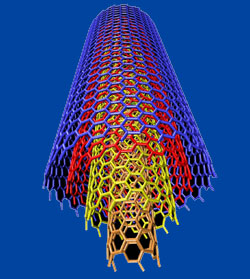The discovery is shared by a team from Rice University and a team of researchers at the Technion

Rice University scientists have unveiled a method for the industrial production of pure carbon nanotube fibers, a method that could lead to revolutionary advances in materials science, energy distribution and nanoelectronics. The method is the successful result of research that lasted nine years and was based on processes used by chemical companies for decades in the production of plastic materials. The research was published in the scientific journal Nature Nanotechnology.
"Plastics is a three hundred billion dollar industry in the US alone thanks to the high productivity of the liquid processing methods used in it," says Matteo Pasquali, professor of chemistry and biomolecular engineering.
"The reasons why grocery stores use plastic bags instead of paper bags and why polyester shirts are cheaper than cotton shirts lie in the fact that polymers can be melted or dissolved and that they can be processed as liquids. Processing nanotubes as liquids promotes the possibility of using liquid processing methods that were already developed in the past for polymers."
The new process is based on the 2003 discovery of the same university that made it possible to dissolve large quantities of pure nanotubes in highly acidic solvents such as sulfuric acid. The research team found that the nanotubes in these solvents arrange themselves, similar to spaghetti noodles in their packaging, to form liquid crystals capable of being processed into thin single fibers the size of a human hair.
"From this research, a suitable industrial process for nanotubes was developed that corresponds to the methods used today to make Kevlar (Kevlar, a brand name of a strong and resistant aramid fiber used in the production of protective clothing, protective vests, protective clothing, tires, optical fibers, etc.) from rod-like polymers, Except for the fact that the acid is not a real solvent," said one of the researchers.
"Our current research shows that we have a real solvent for nanotubes - chlorosulfuric acid - which is the goal we set for ourselves when we started this project nine years ago." As a direct continuation of the breakthrough made in 2003 with acidic solvents, the team began to systematically examine how the nanotubes behave in different types and concentrations of acids. By examining the behavior of nanotubes in acids and comparing it to the literature knowledge about polymers and rod-like colloids, the team developed both theoretical and practical tools that chemical companies will need for industrial processing of the nanotubes.
"Yashi Talmon and his colleagues from the Technion performed the crucial step required to present direct evidence that nanotubes do dissolve independently in chlorosulphuric acid," explains the lead researcher. "To that end, they were required to develop cutting-edge experimental methods to directly observe rapidly frozen solutions."
Talmon explains: "The research was extremely challenging. The research group of the scientist Matteo not only had to pioneer innovative experimental methods to achieve this goal, but also had to carry out a significant expansion of the classical theories used for rod solutions."
The team from the Technion had to develop an innovative scientific research method to allow us to obtain high-resolution images of the nanotubes dispersed in chlorosulfuric acid, a highly corrosive liquid, using an advanced electron microscope at cryogenic temperatures."
Few technological breakthroughs have generated as much enthusiasm as carbon nanotubes. Since their discovery in 1991, carbon nanotubes have been heralded as a cure for cancer to a solution to the global energy crisis. This enthusiasm is even more amazing if we remember that working with nanotubes is extremely complex and that chemists all over the world have struggled for years to make them.
Why does enthusiasm exist? Simple and to the point - extraordinary carbon nanotubes. Although they have the same sizes and shapes as several rod-like polymers, carbon nanotubes are capable of conducting electricity similar to copper, and can appear as both metals and semiconductors. They can be combined with antibodies for the diagnosis of diseases or heated using radio waves so that they can eliminate cancer cells in a targeted manner. They are used to make transistors much smaller than those available today in microchips. They weigh about a sixth of the weight of steel but are able to be a hundred times stronger than it.
"Kevlar, the polymer fiber used in protective vests today, is ten times stronger than our strongest nanotube fibers, but basically we are able to make our nanotubes a hundred times stronger," explains one of the researchers. "If we can fulfill even just twenty percent of our capacity, we will have an amazing substance, perhaps the strongest ever. "Already today, the electrical conductivity of the nanotubes is quite good," he adds. "It is similar to the conductivity found in the most conductive carbon fibers available today, and it could be two hundred times higher if we could develop better manufacturing methods for metallic nanotubes."
However, a final breakthrough is still required before the true potential of high-quality carbon nanotubes is realized. This is because with the existing methods mixtures of nanotubes with different diameter, length and molecular structure are obtained. Scientists around the world are struggling to find a process that will yield only one type of nanotube in large quantities, similar to their metallic conductive counterparts.
"One of the advantages of our process is that if we are given one gram of clean metallic nanotubes, we can turn it into one gram of fiber within a few days," explains the researcher.

2 תגובות
I imagine such fibers only flexible and pleasant like cotton only airy like these perforated fibers.
And for what?
Airy clothes for the Israeli summer.
This does not mean that it will be possible to build nanotubes from this acid